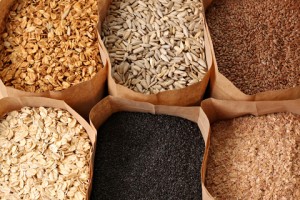A Whole Grain Primer

You’ve heard that you’re supposed to eat more of them, but what the heck are whole grains, exactly?
Whole grains are grains that haven’t had their bran and germ removed by milling. They’re considered a better source of fiber, nutrients and antioxidants than their refined cousins. Whole grains can decrease cholesterol levels, blood pressure and risk of heart disease, and some studies have found that whole grains help reduce the risks of certain types of cancer.
The whole grain family includes brown rice, buckwheat, farro, millet, oatmeal, whole-wheat flour and whole cornmeal, among others. The FDA recommends eating at least three one-ounce equivalents of whole grains per day. Want to see if your packaged food product contains whole grain? It’s easy. Just look for the word “whole” in the ingredient list.
If you’re a refined-grain guru, incorporating whole grains into the diet might seem like a pain, but trust me, it’s pretty painless if you start small. For instance, substitute whole-wheat pasta or go for whole-grain bread products (think bagels, English muffins, tortillas, etc.) for white-flour options. Or if you’re baking, try using half whole-wheat pastry flour in cookie, cake or pie recipes. I’ve had particular luck with this in bar-cookie recipes, like these pumpkin chocolate chip squares (it’s also been virtually undetectable in 7-layer bars and other bar cookies). Whole wheat pastry flour is a much finer grind than regular whole-wheat flour, and while yes, the texture is a little teeny bit different, it’s not off-putting. In fact, once you get used to it, you might actually prefer the slightly nutty taste of the whole wheat pastry flour.
A dinner-time suggestion: Try brown rice instead of white. Use vegetable or chicken broth rather than water (same ratio as white rice – two cups broth to one cup of rice, and try adding a teaspoon of olive oil and a pinch of salt to boost the flavor). Or switch out rice altogether and give quinoa a whirl. If you’ve read this blog for a while, you know that I’m a huge fan of this high-protein seed. It acts like a grain, cooks quickly and has a light, nutty flavor.
Hungry for more? Here’s a clue as to what each whole grain is, and what to do with it:
Amaranth. These seeds are crunchy and flavorful. Toast the seeds in a dry, covered skillet over medium heat until browned and beginning to pop, or simmer 1 cup of the seeds in 2 1/2 cups of water and eat it like oatmeal. Amaranth flour can be used in cookies or pastas.
Buckwheat. Also called “groats” or “toasted groats” (which are labeled kasha – is this confusing, or what?). Add 1 cup of groats or kasha to 2 cups of salted boiling water and simmer until the liquid has been absorbed, about 10 minutes. Let stand covered briefly, then fluff and serve in place of rice in pilafs.
Bulgur. These are wheat berries that have been steamed, dried and cracked. Look mostly for the fine grind – it’s less chewy and may be easier to love initially. Add 1 cup of bulgur to 2 cups of salted boiling water and simmer until the liquid has been absorbed, about 10 minutes. Let stand covered briefly, then fluff and serve. Use in tabbouleh, salads, or with sausage and kale, or chicken and broccoli.
Cornmeal. Use whole-ground cornmeal in pancakes, corn tortillas and cornbread, or as polenta.
Farro. An ancient strain of wheat with a chewy texture and nutty flavor. Soak farro for at least 20 minutes and for up to 12 hours, then simmer in a large pot of heavily salted water until tender, 20 to 40 minutes depending on the type of farro being used. Drain and serve.
Millet. Takes about 15 minutes to steam, and can be mixed with vegetables and stuffed in roasted red peppers, tomatoes or zucchini.
Oats. These puppies are high in fiber and can help lower cholesterol. Oats are most often eaten for breakfast, but they can also be used in cookies, bread and cereal, for thickening soups and for brewing beer.
Quinoa. High in protein and amino acids. Rinse quinoa thoroughly with water before cooking to remove its bitter coating. Cook for about 15 minutes and use in place of rice, or in soups, stews or stir-fries, or as a breakfast cereal. Here are some tasty quinoa recipes for you to try.
Teff. This is the staple grain of Ethiopia. It’s gluten-free, and can be used to make flatbread or to lighten baked goods.
© 2010, Sarah. All rights reserved.











Pingback: Tuesday Tidbit: Is Your Wheat Really Whole? — Semi-Sweet